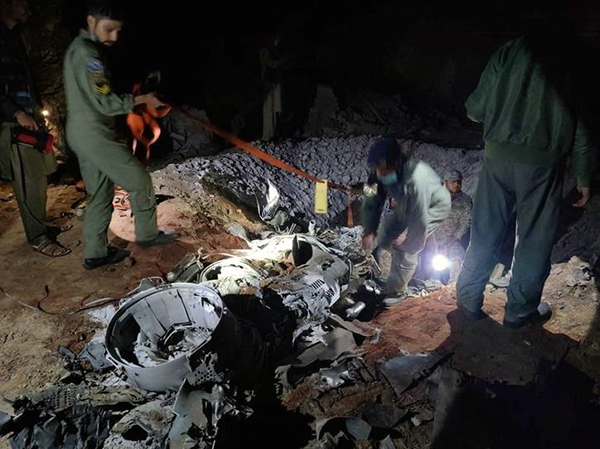
India Regrets Accident, Orders Inquiry
On 10 March, Pakistan’s Director-General Inter-Services Public Relations (DG ISPR) alleged in a press conference that Pakistan’s Air Defence Operations Centre had on the evening of 9 March picked up a high-speed flying object that had been launched from near Sirsa (Haryana). The object initially seemed to be heading towards Mahajan Field Firing Ranges (MFFR), but after 70-80 kilometres, it suddenly turned towards Pakistan, flew at speeds up to Mach 3 and reached an altitude of 40,000 feet, travelled 124 km inside Pakistan and finally landed at Mian Channu, Khanewal district (northwest of Multan), damaging three houses. It also said that Pakistan had recovered the debris and was examining it.
On 11 March, Pakistan summoned India’s Charge d’Affaires and officially voiced “strong condemnation of this blatant violation of Pakistani airspace”, after which India admitted that on 9 March, it had accidentally fired a missile that landed in Pakistan and that it “deeply regretted” the incident. It added that the accident occurred due to a technical malfunction during a routine maintenance check and that the government had “taken a serious view and ordered a high-level Court of enquiry”.
Reports suggested that an inspection and protocol revision was being carried out at a secret satellite base. The missile followed the correct trajectory and also ruled out speculation about the launch being part of an actual firing test. No NOTAM issued. A NOTAM or notice to airmen is a warning issued to alert pilots of potential hazards on a flight route or at a location that could affect the flight.
Missile trials do not take place in the Field Firing Ranges in the west. All trials are held on the eastern flank and from the Andaman and Nicobar Command.
India Regrets Accidental Firing
Noting that the incident was regrettable, a statement by the Ministry of Defence said on 11 March, “The Government of India has taken a serious view and ordered a high-level court of enquiry”.
The statement also said that the missile had entered Pakistan from India on 9 March due to “accidental firing” caused by “a technical malfunction” in the “course of routine maintenance”.
Likely to be BrahMos
From the tracking data (particularly the speed, altitude reached) released by Pakistan’s DG ISPR and the pictures available, it seems fairly certain that the object was India’s supersonic BrahMos cruise missile. Perhaps the latter was being updated with targeting data, or its systems were being tested for full-functionality, and it got fired inadvertently. Or as some reports suggested it was a training inert version of the missile.
There was speculation that India had deliberately fired the missile to test Pakistan’s missile defence readiness. This theory does not seem plausible since it would risk the latest weapon falling into inimical hands.
Human Errors
The incident showed India’s handling of its strategic weapons and launch protocols in poor light. Given the long-running tensions between India and Pakistan, this inadvertent launch could have easily led to a rapid escalation to nuclear levels.
The timings provided by Pakistan show that the Indian missile was airborne for about seven minutes before its impact near Mian Channu and could have easily been misconstrued as an Indian pre-emptive strike on a Pakistani strategic facility – Multan is one of Pakistan’s nuclear weapons sites.
What is surprising is that the missile system has several mechanical and software safety mechanisms to prevent any kind of accidental firing. The missile has multiple geo-locations of targets fed into the system, which need to be selected or new ones added. There are also multiple steps of clearance, including the entry of certain codes before the countdown starts, after which the missile goes into auto mode.
Pak Air Defence Failed
The statement by Pakistan Air Force spokesperson Air Vice Mshl Tariq Zia on 10 March saying, “the projectile travelled 124 kilometres inside Pakistani territory in three minutes and 44 seconds” showed that the country’s air defence did not work against the missile.
While the incident had occurred on 9 March evening, Maj Gen Iftikhar held his press conference next day, more than 24 hours after the missile landed, which also went against Pakistan’s claim of having tracked it from the time of its launch.
Pakistan’s also sought details of the missile’s flight path/ trajectory, and how it ultimately turned and entered the country.
Pakistan Questions India’s Ability
Pakistan’s National Security Advisor Moeed Yusuf questioned India’s ability to handle sensitive technologies and called for an investigation into its “inadvertent” launch of a missile that landed in Pakistan. Yusuf said in a series of tweets that the Indian government did not bother to inform Pakistan about the incident.
He said that the missile had travelled close to the path of international and domestic airlines and threatened the safety of civilians. He also called out the Indian authorities for not informing Pakistan immediately that an “inadvertent launch of a cruise missile had taken place”.
He regretted that Pakistan’s repeated calls urging the world to take notice of “India’s irresponsible behaviour” had been ignored and New Delhi continued to pose a threat to regional stability.

















